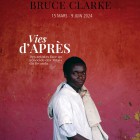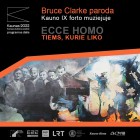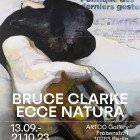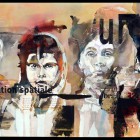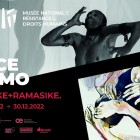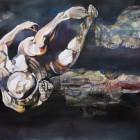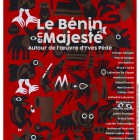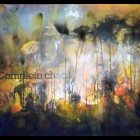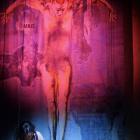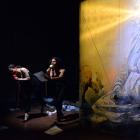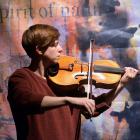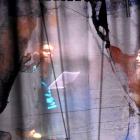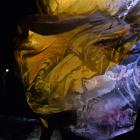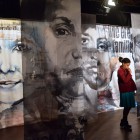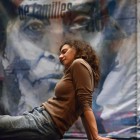Visual and theoretic writings
"Concerning the formal element, I use ripped, lacerated fragments of paper, newspaper, posters etc. I work them, rough them up, soak them in colour. Words and colour, words and images become one and are recomposed on the canvas. The words and texts don''t necessarily have direct links with the images; they aren''t descriptions of the images and the images aren''t illustrations for the words; I''m not commenting, I''m recomposing after having flattened the figures on the painted surface. The documents I use come from a certain context: the media, the press, tele-visual images, the flood of "information" which assails us daily. These formal elements are then transformed and re-placed in another context, which is basically a canvas on a stretcher.
In one sense, the "found" and chosen fragments are first "de-contextualised"- to give them a different meaning, a meaning often very different from the original one. There''s a sort of transfiguration, a displacement of meaning. I deconstruct in order to "re-present", with my own proper sensitivities to meanings. It''s precarious: I put myself into the situation of go-between, of "medium", to accompany the passage."
Bruce Clarke, Interview, August 2002
From Concept to Designation
This long quotation doesn''t need any commentary; it''s almost a programme. However, we can put the principles included in this procedure into the perspective of contemporary creation. It goes without saying that we mean contemporary "Western" creation because it seems that contemporary creation from "the rest of the world" in no way fits in with these schema. As we saw with Picasso''s Guernica, movements of rupture in art are often carried through by surprising people or by disconcerting practices, which in the end reveal new sensitivities.
In the sixties, conceptual art brought about a definitive separation between artistic and aesthetic activity. The designation, the naming of a work, was enough to make it exist, reardless its "envelope" or support. The work came into being because it was designated as such. This is what makes Anne Coquelin say "contemporary art belongs to the realm of communication", proving Marcel Duchamp and Andy Warhol partially right.
Thus reflection on language, the notions of exhibition and of designation become important at the same time as the refusal to see the "work of art" as an object. These ideas were developed by numerous art movements close to conceptual art tendencies such as Art and Language in Britain, BMPT in France as well as the New Realists and Narrative Figuration. What too was innovative in the sixties was to transform urban space and technological resources into integral elements of the creative process.
One of these tendencies, for example, was to introduce lacerated billboards (Raymond Hains, Jacques de la Villeglé) into the pictorial syntax. Common to these techniques was a new perceptive approach to the real, closer to a sociological vision than to the artistic phenomenon. The practice of archiving, of fragmentation or accumulation to produce collages-assemblages as end products became common.
In fact, aesthetics were replaced in the artistic field by sociology and associated disciplines: an outward vision of the world, commitment, contestation and analysis of the force of images.
What were the reason for these changes in direction?
"The visual arts have acquired (in 1996) a global social importance completely independent of formalists conceptions and the presence of an aesthetic. The visual tradition of a culture incorporates the image that it has of itself. Thus art covers a lot more than pure aesthetics. At present it is questions of identity that are in the forefront of culture generally and visual culture particularly".
(Thomas Mac Evilley, Art & Otherness, Cultural Identity in Crisis, p. 109)
To be schematic, and pushing the logic of Mc. Evilley, we can say that Western art history has been articulated around two poles: The first pole coming from colonialism and primitive forms of globalisation through the slave trade (as Bruce Clarke has defined it) began in the Renaissance (15th century) and finished when the first colonial powers began to give up their overseas possessions (middle of the 20th century). The second pole, in parallel with post-modernism, is decolonisation still at its beginnings, and meaning not only the retreat of colonial powers, of their military influence, but also the long period of readjustment, reconstruction and re-composition which follows colonialism in the former colonies.
It goes without saying that the above applies to the visual arts: giving meaning to appropriation, quotation and other basic techniques from the 1980s onwards.
Historical and artistic processes are working in parallel: ideas of collage, fragmentation and heterogeneity correspond to interpenetrations of identities, to mixing and social transformations linked to contemporary globalisation.
The Fragment
The intrusion of fragments into the real (bits of paper, cloth, different objects), into the pictorial space is a way of underlining the ruptures or discontinuity in visible forms. They were introduced after the first attempts by the cubists in the 1910s. From 1912, Braque started using fragments of "images-signs" in his paintings. The fragment contains its own limits, it brings a broken, unfinished appearance to the composition, it disrupts and disturbs but also controls the assemblage and re-composition by crystallising meaning in a limited space. Whilst refusing an all over reading of the work, paradoxically it participates in imposing one.
The fragments of paper and other collage elements in Bruce Clarke''s work are taken as unique entities, individual, soaked, covered, plastered to thicken and opacify the support before reappearing in another way as part of a huge palimpsest. The onlooker has a global reading of the fragments which pull together the unconnected elements thus giving them new unity. Disparate elements come together giving meaning to the composition. The assemblage of fragments is not arbitrary, but thought through; the fragment is a piece of the broken structure (the conscience) which can be restructured, that needs to be saved from the disaster of remaining a piece of waste. The waste itself is there on the floor in the studio, and what is "saved from disaster" is glued as a fragment of life, onto the canvas.
Collage-Montage
In his Merzbauen (circa 1910-20), Kurt Schwitters was the first to bring visual arts, advertising, graphic arts and typography together in a whole. But it''s really Pop Art in the 50s and 60s, that consolidated the gesture of collage: Robert Rauschenberg, Andy Warhol, Jasper Johns... and all those who were preoccupied by the links between the (fragmentary) real and its representation. At times the object itself became raw material for collage (the ready-made). The act was fundamentally one of transformation, a heritage of Dadaism and Surrealism. A way of avoiding the dominance of order imposed by the real world, a way of recomposing it as artist''s vision, of fathoming the depths of images and their relationship to graphics and typography and the pictorial aspects on the canvas.
Montage is a reference to cinematographic techniques and is a response to the rules of putting together filmed images. Developed and theorised by S.M. Eisenstein, the results of a montage correspond to a new product rather than a sum of different products. The Russian filmmaker thought that he had to "deconstruct" narration because montage must transform reality and natural phenomena: it must attempt to demonstrate rather than show. His cinematic discourse revolves around fragments taken out of the real world and which find new meaning in the relationship that they establish between each other. A shock must be produced between two independent fragments; they must be assembled in a conflict mode (graphic, rhythmic, spatial) in order to produce a collision at different levels. This is what S.M. Eisenstein called the "montage of attractions".
Michèle Baj-Strobel




